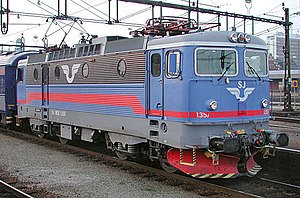SJ Rc

Rc6 operated by SJ
|
|||||||||||||||||||
|
|||||||||||||||||||
|
|||||||||||||||||||
|
|||||||||||||||||||
| Type and origin | |
|---|---|
| Power type | Electric |
| Builder | ASEA |
| Build date | 1967–88 |
| Total produced | 366 |
| Specifications | |
|---|---|
| AAR wheel arr. | B-B |
| UIC class | Bo′Bo′ |
| Gauge | 1,435 mm (4 ft 8 1⁄2 in) standard gauge |
| Wheel diameter | 1,300 mm (51.18 in) |
| Length | 15,400 mm (50 ft 6 1⁄4 in) |
| Loco weight | 80 t (79 long tons; 88 short tons) (Rc1) 76.8 t (75.6 long tons; 84.7 short tons) (Rc2, 3) 78 t (77 long tons; 86 short tons) (Rc4, 6, 7) |
| Electric system(s) | 15 kV 16 2⁄3 Hz AC Catenary |
| Current collection | Pantograph |
| Performance figures | |
|---|---|
| Maximum speed | 135 km/h (84 mph) (Rc1, 2, 4, 5) 160 km/h (99 mph) (Rc3, 6) 180 km/h (110 mph) (Rc7) |
| Power output | 3,600 kW (4,800 hp) |
| Tractive effort | 275 kN (62,000 lbf) (Rc1, 2) 235 kN (53,000 lbf) (Rc3, 6) 290 kN (65,000 lbf) (Rc4) |
The SJ Class Rc is the most used electric locomotive in Sweden. Rc is a universal locomotive used both in freight and passenger trains. The largest operator is Green Cargo, although SJ, Veolia Transport, Tågåkeriet, Hector Rail and the Swedish Transport Administration operate it as well.
The Rc-locomotive first appeared in 1967 to replace the 1950s Ra-locomotive, the 1940s F-locomotive and the older D- and Da-locomotives.The locomotives are notable for using thyristors instead of the older diode based system.
As of 2007, Green Cargo operated the Rc locomotives on the iron ore line between Kiruna and Gällivare in Northern Sweden.
Altogether there have been 8 versions of the Rc-locomotive in Sweden including the freight locomotive Rm designed to pull iron ore trains. Rc1, Rc2, Rc4, and Rc5 have a maximum allowed speed of 135 km/h. Rc3 and Rc6 have a maximum allowed speed of 160 km/h. Rc7 was a rebuild of Rc6 meant to haul replacement trains needed when the X 2000 trains were canceled or delayed. Rc7 had a maximum allowed speed of 180 km/h. However, the maximum speed permitted without emergency electromagnetic track brakes is 160 km/h, and converting the carriages proved too expensive. For that reason all Rc7 were subsequently converted back to Rc6. Rc1–Rc7 all weigh between 75 and 80 tonnes, whilst the Rm weighs 90 tonnes. The Rm's top speed is only 100 km/h, but due to the nature of their work, they are more powerful locomotives.
Engines based on the Rc design has been sold to other countries. The Austrian Federal Railways bought 10 Rc2 with extra brakes for the alpine conditions, ÖBB Class 1043. One of the locos was badly damaged in an accident but the remaining nine have been bought by the Swedish company Tågåkeriet i Bergslagen AB (TÅGAB), and returned to Sweden. A slightly altered Rc4 has been sold to Norwegian State Railways of Norway, known as El 16. The RAI 40-700 class (see Iranian Railways RC4) of eight engines were exported to Iran in the early eighties for use on the electrified stretches near the then-Soviet border; these were based on Rc4 but with Rm-type bogies, sand-proof air filters and no round windows on the side. In 1977, an Rc4 was tested in the United States for use with Amtrak's passenger trains. The Rc4 engine proved successful and would become the basis for the AEM-7.
...
Wikipedia
